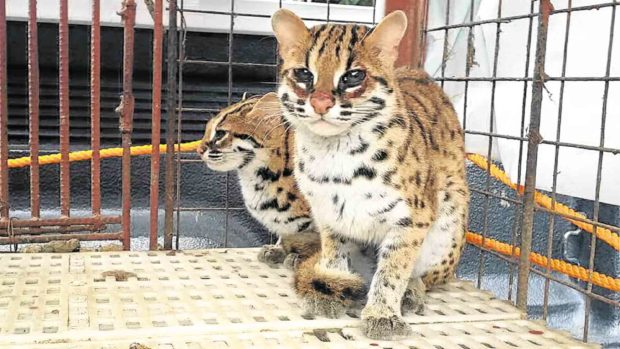
HELLO KITTY These Visayan leopard cats, seen roaming near a poultry farm in Capiz province last year, are named Ponte and Vedra after the town where they were rescued. The rare native wildcats have been turned over to a wildlife park in Iloilo province last month. PINOY GONZALES/Contributor
ILOILO CITY, Iloilo, Philippines — In March last year, poultry workers in Pontevedra town, Capiz province, saw two kittens roaming in the fields near the chicken farm.
But they noticed that the kittens, who seemed lost, had unusual features, prompting them to bring the cats to the poultry owners in Iloilo province.
“From the moment the kittens were brought to me from the farm, I researched about local wildcats on the web and saw the photo of the Visayan wildcat. That’s when I knew I had to take extra care of them until I can find a conservation park so I can endorse them,” said Dr. Marigold Gonzalez, whose family owned the property where the kittens were found.
Indeed, the felines were unique. They are Visayan leopard cats (Prionailurus bengalensis rabori), a species of small wildcats endemic to the Negros-Panay region.
‘Vulnerable’
While the International Union for the Conservation of Nature (IUCN) lists the Visayan leopard cat as “vulnerable” as of June 30, 2008, Dr. Victor Gonzales, director of the Mariit Wildlife and Conservation Park in Lambunao, Iloilo, said the native wildcat was now considered an endangered species, with a very high risk of extinction in the wild.
The IUCN described the population trend as “decreasing.”
Gonzalez, a cosmetic surgeon and daughter of the late former Iloilo City Rep. Raul Gonzalez, fed and took care of the felines when she received them when these were three months old.
When they reached a year and three months on June 28 this year, she had them transferred to the Mariit Wildlife and Conservation Park at the West Visayas State University’s Lambunao campus in Barangay Jayubo.
The male cub, Ponte, and his sister, Vedra, were named after Pontevedra, the town where they were found.
They joined three other Visayan leopard cats (locally called “madal” or “maral”) that were surrendered to the park early this year by Lambunao hunters who found them in the town’s mountains.
Surprise
“The Visayan leopard cats are normally found in the mountains of Janiuay, Lambunao and Calinog towns in Iloilo and Tapaz town in Capiz. We were surprised they found them in Pontevedra,” said photojournalist and wildlife enthusiast Pinoy Gonzales, who suggested to Gonzalez that she send Ponte and Vedra to the conservation park.
Gonzales believed that the maral were living near the waterfalls within the property of the Gonzalez family in Pontevedra.
“There are still huge trees and the environment is something kind of wild over there. But the neighboring farms are already tilled and developed,” said Gonzales.